by Sheila Dunning | Jun 14, 2022
Florida is rapidly urbanizing with 1,000 people a day moving into the state. Many cities in the panhandle have experienced accelerated growth rates over the past ten years. Crestview is one of the seven areas in the state with a population growth of 19% or greater, and the only one located in the panhandle. The 2030 predictions for Florida are another 6 million people, with counties containing military personnel increasing the quickest.
All of these people need water to meet their daily living needs. The average person in the United States uses 101.5 gallons of water per day. Residential water use comprises 61% of the public supply category. This category is responsible for the largest single portion (43%) of groundwater withdrawal in Florida. The Floridan aquifer spans an area of about 100,000 square miles in the southeastern United States, including all of Florida, as well as, portions of three other states. At the current statewide population growth rate, Florida is facing a 300 million gallon per day shortfall of future water needs, possibly as early as 2030.
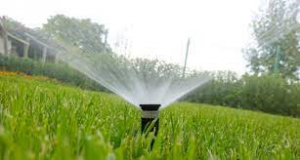 Turfgrass is a key landscape component and often the most commonly used single type of plant in the residential landscape. However, on a hot, sunny day in midsummer, the average lawn uses 125 gallons of water per 1,000 square feet. Although Florida has a humid climate where the precipitation rate, on average, is greater than the evapotranspiration rate, the low water-holding capacity of the soil makes irrigation necessary for the high quality landscapes desired by homeowners. But, watering the yard requires an entire household to skip a shower, not wash anything and avoid cleaning. Or, we need to find ways to use a different source of water for irrigation and conserve the potable water for the people.
Turfgrass is a key landscape component and often the most commonly used single type of plant in the residential landscape. However, on a hot, sunny day in midsummer, the average lawn uses 125 gallons of water per 1,000 square feet. Although Florida has a humid climate where the precipitation rate, on average, is greater than the evapotranspiration rate, the low water-holding capacity of the soil makes irrigation necessary for the high quality landscapes desired by homeowners. But, watering the yard requires an entire household to skip a shower, not wash anything and avoid cleaning. Or, we need to find ways to use a different source of water for irrigation and conserve the potable water for the people.
While the use of reclaimed water for landscape plants has become a standard in many parts of Florida, it has limited availability in the panhandle. However, there are many ways to reduce and conserve potable water use for those with in-ground irrigation systems. First, make sure you have a functional rain shut-off device. By design it will prevent the system from running when it has recently rained. On average, the panhandle has received rain about every 4 days this year. Besides, Florida law requires a rain shut-off device for all irrigation systems, new or old.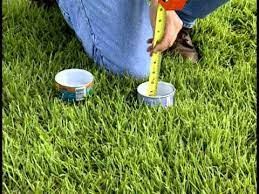
Then, calibrate each zone to determine the length of time required to deliver ½ inch of water. This can be determined by placing 10 or more, short, straight-sided containers throughout the irrigation zone. Run the system and look at each container, measuring the depth with a ruler. Adjust the run time so the system only delivers ½ inch. Now set the clock to run 2-3 times a week for that length of time. It’s that simple. And the water savings is significant. For these and many other irrigation tips, visit askIFAS at https://edis.ifas.ufl.edu/.
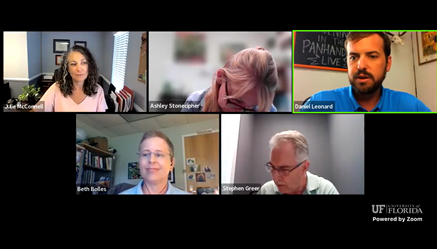
by Matthew Orwat | Jun 14, 2022

The Q&A on Native Pollinators and their Favorite Flowers offered valuable information on many types of flowers that feed our many species of pollinators in Northwest FL. Below are the reference materials related to specific questions that were asked along with notes from the panel discussions.
- Stephen Greer was asked which garden perennials are best for pollinators, he mentioned that Blanketflower, Cardinal Flower, Black Eyed Susan were his top three.
- Julie McConnell was asked, what are some shrubs to benefit birds and pollinators? She stated that insects forage off lawn grasses, but good shrubs are Wax Myrtle, Saw Palmetto, American Beautyberry, Vibernum and Holly Species. Sandy Soil Pollinators: Firebush, Holly, Saw Palmetto, all drought tolerant and good for pollinators.
- Julie McConnell was asked about Fall Pollinator Plants, replying Swamp Sunflower as her favorite.
- What about Winter Pollinator Plants?
- Winter: Mahonia, Fatsia, both good plants for pollinators in shady areas, also Beth added that winter vegetables help pollinators in the winter, such as carrot, wild radish, provide forage for bees, bumblebees and plasterer bees, carpenter bees. Matt Lollar said daikon radish is another good pollinator plant for fall and winter.
- Question from Facebook: Are Loquat trees good for pollinators. How large do they get and when do they bloom? Do they need shade or full sun?
- Are Spicebushes good Pollinator Plants?
- Herbs: Perfect Plants for Pollinators
- What is best for Butterfly Gardening in Florida?
- What are some Favorite Pollinator Plants?
- Better access to native plants: Florida Native Plant Society
- https://www.fnps.org/
- There are Native Plant Nurseries in Bay and Leon County, you can find them on google.
- Some Master Gardner Volunteer programs sell native plants at their sales!
- Stephen: What methods have been successful to approach HOA’s to approve of Native plants in homeowner’s properties?
- Build consensus about native plants before the meeting.
- Covenants or Bylaws. Covenants are less enforceable, Bylaws have enforcement ability.
- Beth: Do we need to supply water for pollinators? YES!
- Is Carolina Jessamine good for bees?
- Growing Sunflowers from seed:
- How Much Bidens alba is enough?
This episode of Gardening in the Panhandle LIVE! is available to watch at https://www.youtube.com/watch?v=BGl4kGYEEs4.
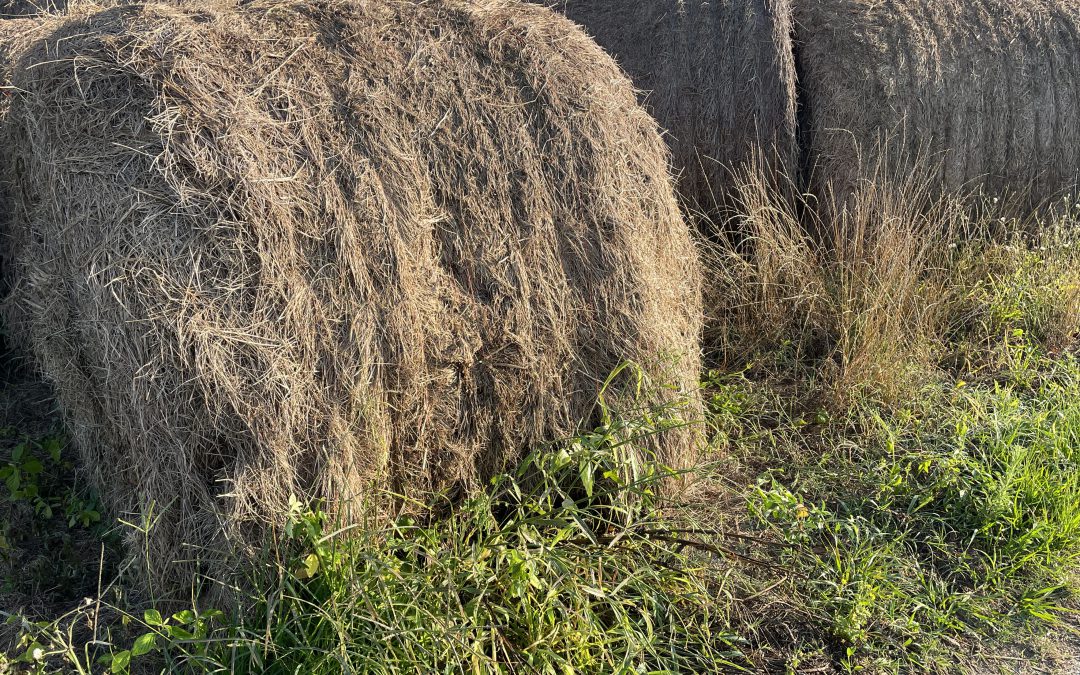
by Matt Lollar | Jun 9, 2022
This article was written by Kacey Aukema, University of Florida/IFAS Extension – Walton County.
I recently met with a home gardener who brought in tomato plants showing strange symptoms on the leaves. Together we puzzled over the odd leaf-curling symptoms that were affecting their tomato beds, but not other areas of the garden. Upon further investigation it was revealed that hay, used as mulch, had recently been spread around the tomatoes, but not in other areas of the garden. It quickly became apparent that the symptoms were likely related to herbicide residual on the hay that was used. The herbicide aminopyralid was the potential culprit. In this case the residual herbicide was not enough to outright kill the growing tomato plants. However, it was interfering with their growth and development and is a cautionary tale reminding us how important careful sourcing of hay used in mulch or compost can be.
What is aminopyralid and how does residual herbicide affect non-target plants through mulch, compost, etc.?
Aminopyralid is a herbicide active ingredient found in several popular pasture products such as GrazonNext™, Milestone™, Chapparral™ and similar products. This and other similar chemicals have residual activity and can be retained in plant tissues, animal manure, and soil, which makes them a very useful for controlling certain troublesome broadleaf weeds in grass pastures for an extended period of time. Unfortunately, this residual activity increases the potential for causing trouble in vegetables or other crops when hay or animal manure from aminopyralid treated pastures is mistakenly used for mulch, compost, etc. In Florida, aminopyralid containing pasture herbicides are often used as the “go to” for control of hard to control weeds like horsenettle and tropical soda apple which are potentially toxic to livestock. Tomatoes, potatoes, and eggplant are in the same genus (Solanum) as those weeds and are therefore very susceptible to this herbicide as are many other vegetable and other broadleaf crops.
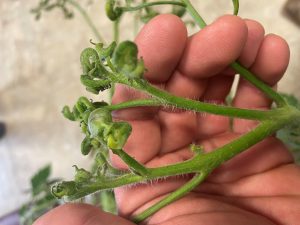
Residual aminopyralid damage on a tomato plant. Photo Credit: Kacey Aukema, University of Florida/IFAS Extension – Walton County
How can I know if hay is safe to be used for mulch or compost?
Before acquiring hay to be used as mulch or to compost for vegetable beds, be sure to ask if the hay is free of herbicides with residual activity. Find out what was sprayed on the field in the last two seasons before the hay was harvested. Given that hay destined to be used as mulch or compost is usually old and spoiled, management history of a particular hay bale is likely to be hard to pin down. Do not trust hay to be used for mulch or compost in vegetable beds if prior spray management details are unknown. Also consider that well-stored hay may retain residual herbicide better and for a longer period of time than weathered hay, as the active ingredient is less subject to weathering and biological breakdown.
Those who use broadleaf herbicide products with residual activity such as those containing aminopyralid are subject to follow herbicide label guidelines. For instance, supplemental labeling of GrazonNext HL™ (including FL, AL, and GA) indicates that hay/straw from fields sprayed in the past 18 months should not be used for compost, mulch, or mushroom spawn. When in doubt refer to the label of the particular herbicide product used on hay you purchase for any restrictions and/or reach out to your local county extension agent if you have questions about a specific herbicide product. Relevant use restrictions and considerations like in this example should be conveyed between hay producer and buyer.
Perhaps you already have some hay for mulch/compost with an unclear management history, or you would like to double-check and be sure that it is safe. How could one test it to see if it was safe to use? There is a test called a “bioassay”, conducted by growing susceptible plant seedlings like tomatoes or beans in small pots with the hay/compost/mulch in question incorporated into the potting soil. Then, the test plants can be observed to see if any herbicide symptoms develop to know whether the material is safe to use, before using the hay over a larger area or garden where there would be more risk. For more information on how to conduct a bioassay see: Herbicide Residues, in Manure, Compost, or Hay. Similar in-field bioassays are also recommended when rotating areas out of pasture and into other crops when pasture herbicides with residual activity were used. If susceptible crops like peanuts are grown in areas where such herbicides were used in the recent past they can be damaged, as in this case in an older Panhandle Agriculture Newsletter post.
When used according to label instructions, herbicides with residual activity are very useful for control of broad-leafed weeds in pasture and hay fields and may reduce the spread weeds through seed coming in on purchased hay. However, problems can emerge when hay from fields treated with these products change hands without the use restrictions and considerations being adequately explained. Therefore, caution should be taken by both producer and buyer to avoid damaging sensitive crops when hay or livestock manure are used for mulch or compost.
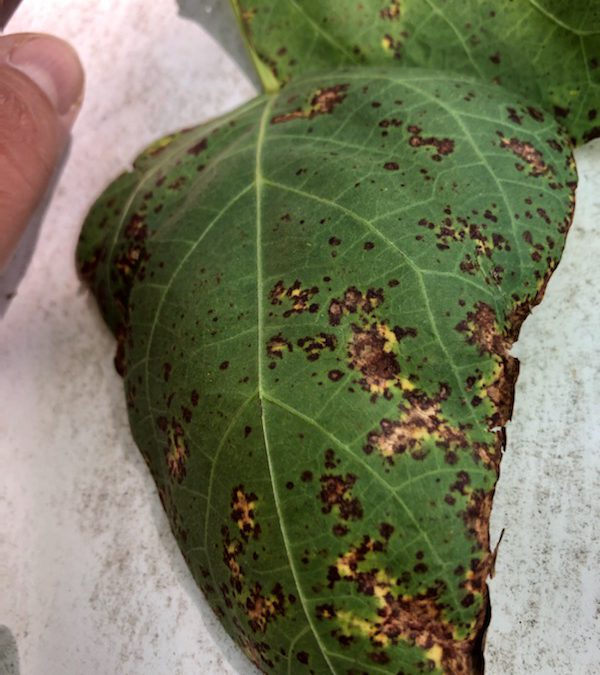
by Matthew Orwat | Jun 9, 2022
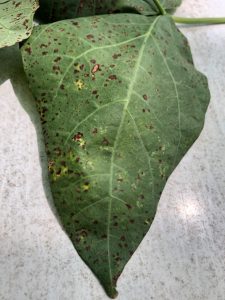
Snap Bean leaf with common bacterial spot – Image Credit Matthew Orwat, UF/IFAS Extension
As snap bean season is winding down and daytime temperatures regularly approach the lower 90s, common bacterial blight is making its presence known. In March or April, when snap bean plants are young and full of fresh growth, vegetable gardeners would never guess that their leafy plants could turn spotty and ugly during harvest time.
That is exactly what happens when daytime temperatures steadily remain in the mid-80s and low-90s, and nighttime temperatures are in the lower 70s. The perfect storm for this bacterial disease occurs when these temperatures combine with afternoon and evening showers, creating sticky, humid nights perfect for the proliferation of the causal agent, Xanthomonas campestris pv. Phaseoli.
Common bacterial blight begins showing up on older leaves first and then slowly spreads to younger growth and pods. If plants are left untreated, disease progression will continue if rainy nights and warm daytime temperatures continue. If weather conditions are consistently dry, daytime temperatures are above 90 and overhead irrigation is limited to mornings or eliminated, the blight will stop progressing to new growth. This disease may also be transmitted by insects.
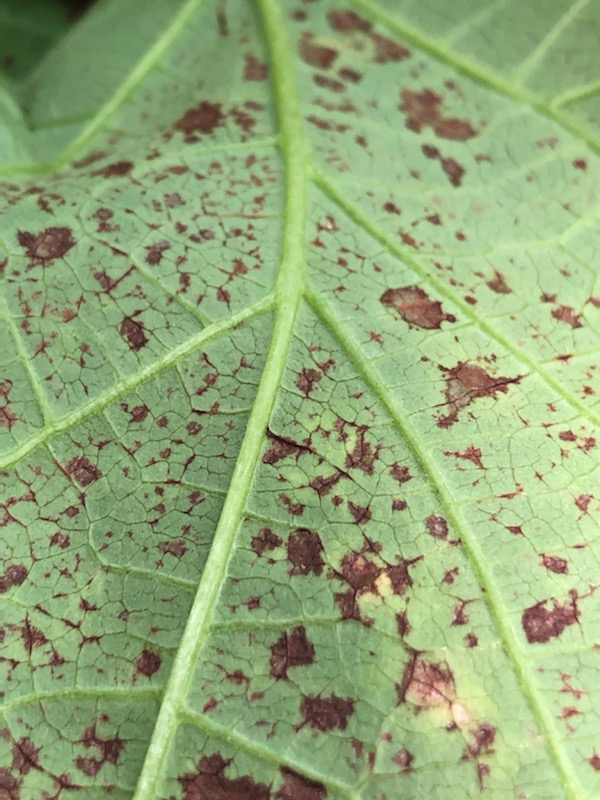
Note the brown, water-soaked spots on the underside of this leaf, typical of a bacterial infection – Image Credit Matthew Orwat, UF/IFAS Extension
If conditions favorable to common bacterial blight exist, preventative sprays of copper fungicide will work to
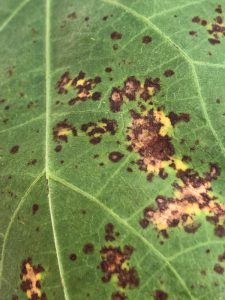
Snap Bean leaf with common bacterial spot – Closeup – Image Credit Matthew Orwat, UF/IFAS Extension
reduce infection and damage to crop, but there is no product to cure what has already been infected.
One of the best techniques available to manage common bacterial blight in beans is to rotate crops regularly so that legumes are not grown on the same ground year after year. This is easily accomplished in a diverse home garden with different raised beds or garden plots.
To learn more about common bacterial blight of bean follow these links to the NFREC Plant Pathology U-Scout page or read IFAS Extension PUBLICATION #PP-62
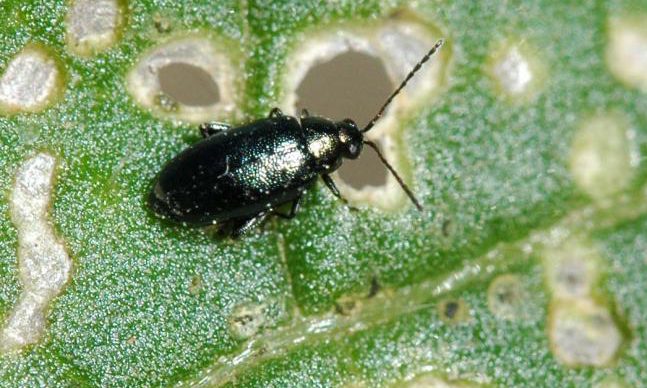
by Donna Arnold | Jun 9, 2022
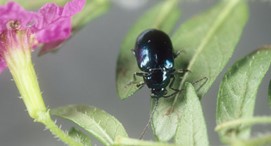
Photo credit Lyle J. Buss, UF/IFAS
The unwanted guest- Flea beetle
Having trouble with flea beetles? Tired of them showing up unannounced? Do not be alarmed here are a few tips to get rid of the unwanted guest in your garden.
Description: Flea beetles vary in appearance, where colors range from black to tan, with other, brighter colors mixed. They may also have a solid, striped, or spotted pattern depending on the species. Beetles are tiny with large hind legs which allow them to jump like fleas when disturbed.
Lifecycle: These unwanted guests will overwinter as adults in the soil or beneath plant debris and become active in early spring when temperatures reach 50°F, and begin feeding on weeds or early-planted crops. Eggs are laid by adult flea beetles normally around May in the soil or at the base of host plants. After 7-14 days eggs will hatch and larvae will feed and develop on various plant parts. They pupate in the soil for 11-13 days before emerging as adults.
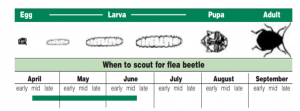
Host plants: Some species attack a wide range of plants, while others target only certain plant families. (Table 1). In the garden, several vegetable crops are eaten by these pests, particularly those in the Brassica family.
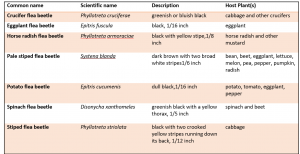
Table 1: Common flea beetles and host plants.
Scouting: Adult flea beetles are particularly active on warm, sunny days. To identify damages, scout every 1-2 days in newly planted fields, since it is easier to identify the damages than to see the beetles themselves. Flea beetle populations can be monitored with yellow sticky traps.
Damage: Adult beetles feed on foliage, producing shot holes in the leaves, especially new leaves which will have a lacy appearance. Additionally, in leafy crops like lettuce or spinach, the holes can reduce the quality of the leaves.
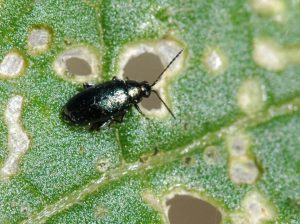
Photo Credits: Jeffery Hahn University of Minnesota
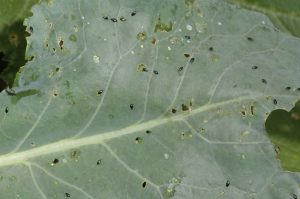
Photo Credit : Jeffery Hahn University of Minnesota.
Management / Control strategies:
- In the spring delay transplanting or planting by a couple weeks if possible.
- In the fall, till the garden to uncover any hiding flea beetles.
- Plant “push” or repellant crops such as catnip, sage, mint, hyssop, nasturtium, and basil.
- Use a “trap crop” such as radishes, taking the pest’ focus off more valuable plants.
- Dusting leaves with plain talcum powder repels flea beetles on tomatoes, potatoes, peppers, and other plants.
- Insecticides may be used early in the season.
- Water deters adult flea beetles. Any watering should be done in mid-day.
- Planting after adults have emerged or crop rotation can help minimize flea beetle damage.
- Apply commercially available nematodes that feed on flea beetle eggs, larvae, and pupae.
Supporting information for this article can be found in the UF/IFAS EDIS publications EENY-721/IN1238: Flea Beetles of the Genus Altica: Altica spp. (Insecta: Coleoptera: Chrysomelid) (ufl.edu); https://entnemdept.ufl.edu/creatures/ORN/BEETLES/flea_beetle.html and https://extension.uga.edu/content/dam/extension/programs-and-services/integrated-pest-management/documents/insect-pdfs/fleabeetles.pdf
 Turfgrass is a key landscape component and often the most commonly used single type of plant in the residential landscape. However, on a hot, sunny day in midsummer, the average lawn uses 125 gallons of water per 1,000 square feet. Although Florida has a humid climate where the precipitation rate, on average, is greater than the evapotranspiration rate, the low water-holding capacity of the soil makes irrigation necessary for the high quality landscapes desired by homeowners. But, watering the yard requires an entire household to skip a shower, not wash anything and avoid cleaning. Or, we need to find ways to use a different source of water for irrigation and conserve the potable water for the people.
Turfgrass is a key landscape component and often the most commonly used single type of plant in the residential landscape. However, on a hot, sunny day in midsummer, the average lawn uses 125 gallons of water per 1,000 square feet. Although Florida has a humid climate where the precipitation rate, on average, is greater than the evapotranspiration rate, the low water-holding capacity of the soil makes irrigation necessary for the high quality landscapes desired by homeowners. But, watering the yard requires an entire household to skip a shower, not wash anything and avoid cleaning. Or, we need to find ways to use a different source of water for irrigation and conserve the potable water for the people.













